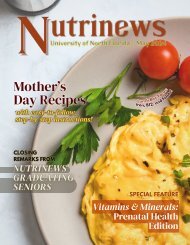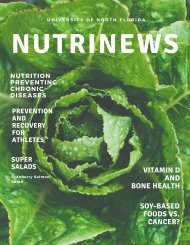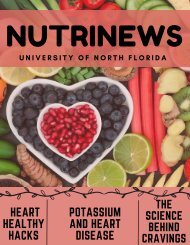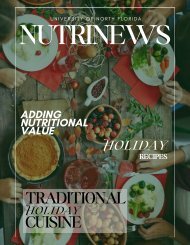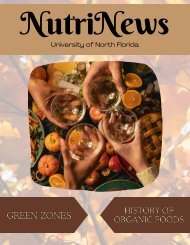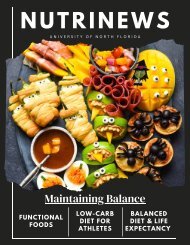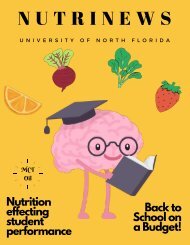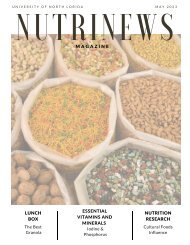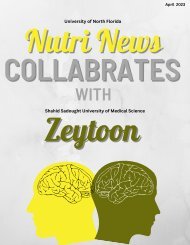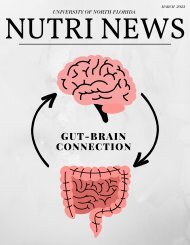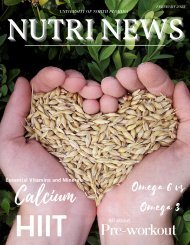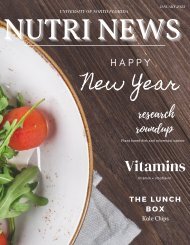October Issue!
The main topic for our October Issue is Fermentation! We have lots of great topics for you this month such as myth-busting, various nutrition science and research articles, and flavor-filled recipes. This month’s student spotlight is on our very own Dewayne Gray. I hope you all enjoy, learn, and get inspired by this month’s articles and recipes!
The main topic for our October Issue is Fermentation! We have lots of great topics for you this month such as myth-busting, various nutrition science and research articles, and flavor-filled recipes. This month’s student spotlight is on our very own Dewayne Gray. I hope you all enjoy, learn, and get inspired by this month’s articles and recipes!
You also want an ePaper? Increase the reach of your titles
YUMPU automatically turns print PDFs into web optimized ePapers that Google loves.
LUNCH<br />
THE<br />
BOX<br />
kimchi (or<br />
Homemade<br />
sauerkraut)<br />
PEASY<br />
EASY<br />
HACKS<br />
MONTHLY<br />
to spot quackery in<br />
How<br />
vs. real science<br />
nutrition<br />
NUTRITION<br />
RESEARCH<br />
benefits of<br />
Health<br />
fermented<br />
consuming<br />
NUTRI<br />
F E R M E N T A T I O N A N D P R O B I O T I C S<br />
NEWS<br />
• T H E U N I V E R S I T Y O F N O R T H F L O R I D A •<br />
based nutrition advice.<br />
vegetables<br />
O C T O B E R 2 0 2 1
contents<br />
2<br />
4<br />
7<br />
C O V I D C O R N E R<br />
10<br />
M Y T H B U S T I N G<br />
13<br />
F O O D S C I E N C E O F<br />
F O O D H I S T O R Y<br />
14<br />
N U T R I T I O N C L U B<br />
U P D A T E : N D L A<br />
S T U D E N T<br />
S P O T L I G H T<br />
S T A F F S P O T L I G H T<br />
18<br />
20<br />
23<br />
N U T R I T I O N<br />
R E S E A R C H<br />
T H E L U N C H B O X<br />
S H O P P I N G I N<br />
S E A S O N<br />
27<br />
28<br />
31<br />
M O N T H L Y H A C K S<br />
37<br />
P R O B I O T I C S &<br />
P E R F O R M A N C E<br />
S L A Y I N G D I E T<br />
C U L T U R E<br />
M E E T T H E S T A F F
4<br />
MYTH<br />
BUSTING<br />
Do Probiotic Supplements Really Benefit Gut Health More Than Fermented Foods?<br />
<br />
Elementary biology classes give the paramount<br />
introduction to bacteria and teach us that<br />
microbes and microorganisms are everywhere.<br />
This knowledge sticks with us for life, however, it<br />
is sometimes difficult to comprehend just how<br />
sophisticated the relationships within the body<br />
truly are. The human body is a host for trillions of<br />
microorganisms, and the gut contains a plethora<br />
of them. “Gut microbiota” is the term for the<br />
intricately balanced composition of bacteria<br />
found within the G.I. tract. The complex<br />
interaction of microbes within the gut provides<br />
the body with benefits such as enhancing the<br />
immune system, increasing the ability to<br />
effectively absorb nutrients, reducing pathogens,<br />
and maintaining homeostasis. When the balance<br />
of microbiota becomes disrupted, or dysbiosis<br />
the body becomes more susceptible to<br />
chronic illness and disease. It is no surprise<br />
then, that probiotic supplements are<br />
frequently prescribed simultaneously with<br />
antibiotics, and are even available for<br />
purchase at drug stores and supermarkets.<br />
Probiotics are live microorganisms intended<br />
to counteract harmful bacteria or provide<br />
balance within the gut when consumed.<br />
Probiotics can also be found naturally in<br />
foods like yogurt, kombucha, sauerkraut,<br />
pickles, miso, tempeh, sourdough bread, and<br />
certain types of cheese.<br />
By: Chloe Morgan
5<br />
Since probiotics can be consumed in supplement<br />
form or through natural foods, there are many<br />
ways to introduce them into the body. Which<br />
method is the safest and most effective?<br />
Probiotics in supplement form have been shown<br />
to reduce antibiotic-associated diarrhea (one of<br />
the most common reasons for prescription), aid<br />
in managing ulcerative colitis, and prevent colic in<br />
infants.4 In such instances, probiotic supplements<br />
with a doctor’s approval are deemed safe and<br />
effective. A healthcare provider can provide a<br />
recommended dosage as well as directions about<br />
when and how the supplements should be<br />
consumed. The drawback to probiotic<br />
supplements is that depending on how and<br />
where they are marketed, they are not always<br />
FDA approved.4 Additionally, there is not enough<br />
evidence to prove that probiotic supplements can<br />
withstand stomach acids and bile salts. Poor<br />
tolerance to the acidic environment in the<br />
stomach can reduce their effectiveness during<br />
digestion and can make it difficult to monitor the<br />
appropriate dosage.6 For these reasons, it is likely<br />
best to follow a doctor or health professional’s<br />
advice when considering probiotic supplements<br />
and consume them only when prescribed, and at<br />
the amount prescribed. Alternatively, consuming<br />
probiotics through fermented foods as part of a<br />
balanced diet is a safe way to add beneficial<br />
microbes to the gut without a doctor’s discretion.,<br />
As well as the potential to aid in homeostasis<br />
within the gut microbiota, naturally fermented<br />
foods contain proteins, vitamins, antioxidants<br />
and minerals that benefit overall health, and<br />
which are not available through supplements.<br />
Consuming foods rich in antioxidants and<br />
vitamins is a good idea for any diet, and the<br />
added benefits probiotics can have on the body<br />
make this method a safe and healthy way to<br />
manage gut health.<br />
Reference List:<br />
1. Thursby E, Juge N. Introduction to the human gut microbiota. Biochem J.<br />
2017;474(11):1823-1836. doi: https://doi.org/10.1042/BCJ20160510<br />
2. Parvez S, Malik KA, Ah Kang S, Kim HY. Probiotics and their fermented food products<br />
are beneficial for health. J Appl Microbiol. 2006;100(6):1171-1185. doi:<br />
https://doi.org/10.1111/j.1365-2672.2006.02963.x<br />
3. Belizário JE, Faintuch J. Microbiome and gut dysbiosis. Exp Suppl. 2018;109:459-476.<br />
doi: https://doi.org/10.1007/978-3-319-74932-7_13<br />
4. Probiotics: What you need to know. National Center for Complementary and<br />
Integrative Health website. https://www.nccih.nih.gov/health/probiotics-what-you-needto-know.<br />
Updated August 2019. Accessed August 28, 2021.<br />
5. How to get more probiotics. Harvard Health Publishing website.<br />
https://www.health.harvard.edu/staying-healthy/how-to-get-more-probiotics. Published<br />
August 24, 2020. Accessed August 28, 2021.<br />
6. Wang Y, Jiang Y, Deng Y, et al. Probiotic supplements: hope or hype? Front Microbiol.<br />
2020;11:160. doi: https://doi.org/10.3389/fmicb.2020.00160
6<br />
O C T O B E R 1 0 T H<br />
W O R L D M E N T A L<br />
H E A L T H D A Y
foods have been growing in<br />
Fermented<br />
over the years, likely due to the fact<br />
popularity<br />
more people are interested in improving<br />
that<br />
gut health.1 Your gut microbiome is home<br />
their<br />
more than 100 trillion bacteria and<br />
to<br />
and plays a major role in the<br />
microorganisms<br />
system.1 Fermented foods contain live<br />
immune<br />
that may improve gut health<br />
microorganisms<br />
provide other health benefits, like lowering<br />
and<br />
risk of cardiovascular disease and<br />
the<br />
Fermented foods include items like<br />
diabetes.2<br />
miso, tempeh, kimchi, and<br />
sauerkraut,<br />
Fermented Foods<br />
How<br />
Improve Your<br />
May<br />
are one of the most highly<br />
Vegetables<br />
foods, making them hard to consume<br />
perishable<br />
people who may not have access to proper<br />
for<br />
techniques or for those suffering from<br />
storing<br />
insecurity.2 Luckily, fermented vegetables<br />
food<br />
an extended shelf life, which makes them<br />
have<br />
for both the wallet and the body.<br />
beneficial<br />
vegetables have different nutritional<br />
Fermented<br />
than their non-fermented<br />
characteristics<br />
due to the activity of enzymes<br />
counterparts,<br />
microorganisms that are at work during the<br />
and<br />
process.2<br />
fermentation<br />
7<br />
Health<br />
By: Haley Brock<br />
kombucha.
of the most valuable benefits of consuming<br />
One<br />
vegetables is the probiotic activity<br />
fermented<br />
is found in these foods.3 Normally, when<br />
that<br />
thinks of probiotics they think of dairy—<br />
one<br />
can be problematic for those who do not<br />
which<br />
dairy. Luckily, fermented vegetables are a<br />
eat<br />
source of probiotics without dairy which<br />
great<br />
suitable for those who follow vegan diets,<br />
are<br />
who are lactose intolerant, or those who<br />
those<br />
looking to lower their cholesterol. Probiotics<br />
are<br />
essential for helping your body maintain a<br />
are<br />
community of microorganisms,<br />
healthy<br />
fermented foods also contain B-<br />
Plant-based<br />
vitamins, which are involved in several<br />
group<br />
functions in the human body3. B-group<br />
essential<br />
are involved in the synthesis of nucleic<br />
vitamins<br />
cell metabolism, and antioxidant activity.<br />
acids,<br />
human body cannot synthesize B-group<br />
The<br />
on its own, so it is important to get<br />
vitamins<br />
from the diet.3<br />
them<br />
particular, kimchi consumption has been shown<br />
In<br />
improve fasting blood glucose levels and other<br />
to<br />
syndrome symptoms in overweight and<br />
metabolic<br />
adults.2 Consumption of fermented<br />
obese<br />
foods has been shown to reduce the risks<br />
soybean<br />
type 2 diabetes and high blood pressure, due to<br />
of<br />
number of phytoestrogens and bioactive<br />
the<br />
found in the food.2 Likewise,<br />
peptides<br />
of fermented soybean paste has<br />
consumption<br />
shown to improve plasma triglyceride levels<br />
been<br />
obese adults.2<br />
in<br />
cultures already consume fermented<br />
Many<br />
on a weekly, or even daily, basis due to<br />
foods<br />
availability and related health benefits.<br />
their<br />
of fermented foods can not only<br />
Consumption<br />
gut health but can also be useful for<br />
improve<br />
who have trouble meeting their daily<br />
those<br />
needs. For these reasons, some<br />
macronutrient<br />
professionals are suggesting that the<br />
health<br />
of fermented foods should be<br />
consumption<br />
as part of public health policy.2 Next<br />
promoted<br />
you head to the store, consider picking up<br />
time<br />
kimchi or sauerkraut—your gut will thank<br />
some<br />
you!<br />
especially after antibiotic use. 3<br />
Reference List:<br />
1. Dimidi E, Cox SR, Rossi M, Whelan K. Fermented Foods: Definitions and Characteristics, Impact on the Gut Microbiota and Effects on Gastrointestinal Health and Disease. Nutrients. 2019;11(8):1806. doi:10.3390/nu11081806.<br />
2. Rezac S, Kok CR, Heermann M, Hutkins R. Fermented Foods as a Dietary Source of Live Organisms. Front Microbiol. 2018;9:1785. doi:10.3389/fmicb.2018.01785.<br />
3. Melini F, Melini V, Luziatelli F, Ficca AG, Ruzzi M. Health-Promoting Components in Fermented Foods: An Up-to-Date Systematic Review. Nutrients. 2019;11(5):1189. doi:10.3390/nu11051189.<br />
8
(FARE) Food Allergy Research and Education<br />
Project Pumpkin Teal<br />
Creates a fun and safe Halloween<br />
experience for children who suffer from<br />
food allergies<br />
Place a teal pumpkin outside your front<br />
door and pass out non-food items<br />
Join the movement now and check out<br />
tealpumpkinproject.org<br />
#tealpumpkinproject<br />
Ideas for non-food items<br />
Glow sticks, bracelets, or necklaces<br />
Pencils, pens, crayons or markers<br />
Bubbles<br />
Halloween erasers or pencil toppers<br />
Mini Slinkies<br />
Whistles, kazoos, or noisemakers<br />
Bouncy balls<br />
Finger puppets or novelty toys<br />
Coins<br />
Mini notepads<br />
Playing cards<br />
Bookmarks<br />
Stickers<br />
Stencils<br />
9
month we are featuring UNF’s Nutrition<br />
This<br />
Dietetics Leadership Association<br />
and<br />
This club is focused on evoking<br />
(NDLA).<br />
leadership potential hiding within<br />
students’<br />
Through various activities during<br />
them.<br />
meetings, NDLA will help its<br />
monthly<br />
understand their personality type<br />
members<br />
strengths/weaknesses, build<br />
and<br />
in making decisions, develop<br />
confidence<br />
skills, and hone networking<br />
communication<br />
techniques.<br />
hosts monthly meetings every second<br />
NDLA<br />
at 3 pm. The meetings will be in<br />
Monday<br />
with a zoom option for those who<br />
person<br />
come to campus. Each meeting is<br />
cannot<br />
in the realm of leadership:<br />
themed<br />
By: Laura Rogers<br />
10
–Leadership Styles and Social Media Tips<br />
<strong>October</strong><br />
this introductory meeting, members will take a leadership style quiz, be taken<br />
During<br />
the process of building an effective Linkedin profile, and even have their<br />
through<br />
taken by one of the senior officers!<br />
headshots<br />
–Leadership Symposium<br />
November<br />
this meeting, NDLA brings in professionals to speak with members about aspects of<br />
At<br />
–Recipe for Success<br />
December<br />
dedicated to the internship, this meeting breaks down the necessary elements<br />
Entirely<br />
–Internship Symposium<br />
January<br />
anticipated event has been coordinated with another nutrition club, SNDA, in the<br />
This<br />
The purpose of the symposium is to bring together professionals who are part of<br />
past.<br />
internship placement process at various institutions. There will be representation<br />
the<br />
–Legislative Day<br />
February<br />
is the yearly event NDLA prides itself on most. This significant occasion involves<br />
This<br />
with legislators on the importance of dietetics and protecting RD licensure.<br />
speaking<br />
members also get the opportunity to witness faculty members stand up for our<br />
The<br />
who attend NDLA meetings are eligible to win a giveaway prize! Joining NDLA can<br />
Those<br />
done through a simple Perch Portal search. Also, be sure to check out their Instagram<br />
be<br />
more information and events.<br />
for<br />
<br />
<br />
@unf_ndla<br />
11<br />
being a leader, and there is also an opportunity for student questions.<br />
needed for landing your ideal placement.<br />
from both local and distance internships.<br />
field.<br />
March –Elevator Pitch, Interview Skills, Networking Techniques<br />
April –Volunteer Event
12
Student Spotlight: Dewayne Gray<br />
By: Carol Riggins<br />
<strong>October</strong> 2021<br />
i, everybody! Pumpkin spice is back and so are we with our next Student in the Spotlight –<br />
Dewayne Gray! Dewayne was born in Bremerhaven, Germany, where he lived for the first two years<br />
H<br />
of<br />
his life before relocating with his family to Weir, Mississippi. Dewayne served in the Unites States Navy<br />
for seven and a half years as a Culinary Specialist. He is currently a Senior in the Nutrition and Dietetics<br />
Program and works as an independent fitness coach. To learn more about Dewayne, continue reading!<br />
CR: What inspired you to pursue a degree in Nutrition and<br />
Dietetics?<br />
DG: I wanted to learn more about how food affects the<br />
body from exercise, and the positives and the negatives [of<br />
food] in sports performance.<br />
CR: What activities or hobbies do you enjoy doing outside<br />
of school?<br />
DG: I enjoy cooking, traveling (especially road trips),<br />
watching sports, going to the beach, and hanging out with<br />
my friends<br />
CR: What has been most challenging to you since<br />
beginning the Dietetics program here at UNF?<br />
DG: Making the adjustment from on-campus class to<br />
remote learning took some time for me to adjust. I had<br />
grabbed a daily planner to get more organized and plan my<br />
days more efficiently.<br />
CR: What advice would you give to incoming students<br />
entering the nutrition program?<br />
DG: Believe in yourself and your abilities. Plan out your<br />
days in advance. It makes life easier.<br />
13<br />
CR: What has been your favorite class in the Nutrition and Dietetics Program?<br />
DG: It’s a tie between community nutrition, nutrition education, and nutrition & fitness.<br />
CR: What plans and goals do you have after graduation?<br />
DG: I plan to apply for dietetic internships and graduate school for sports nutrition.<br />
CR: Do you have a traditional meal or snack you enjoy making that you’d like to share?<br />
DG: I love making jalapeno bombers. I use an onion and chive cream cheese mixed with shredded cheddar, and a<br />
little cayenne pepper wrapped with bacon. [It’s] not bad with turkey bacon either.<br />
CR: Do you have a favorite inspiring quote or mantra that you live by and would like to share with others?<br />
DG: Progression: The Grind Continues. Dedicate time for yourself to become the best version of yourself.
14<br />
STAFF SPOTLIGHT<br />
D R . A R I K A W A I N T E R V I E W<br />
1. What is some of the nutrition<br />
research you have worked on in<br />
the past?<br />
While in my master’s program in Brazil we<br />
worked on developing a snack that was high<br />
in iron. Like many developing countries,<br />
Brazil struggles with micronutrient<br />
deficiencies. So, we were looking to develop<br />
a snack that was low in calories and fat<br />
while being high in iron and vitamin A. I fed<br />
these snacks to animals to see how it would<br />
impact their lipids and other biomarkers.<br />
This is still where my research is focused<br />
today, on biomarkers of inflammation and<br />
how diet may prevent or treat that<br />
inflammation.<br />
2. What research are you currently<br />
conducting here at UNF?<br />
The current clinical trial being conducted is<br />
called the Happy Gut Study and we are<br />
looking at how consuming fermented<br />
vegetables will impact the gut microflora<br />
and biomarkers of cardiovascular disease,<br />
including inflammatory markers. This trial is<br />
registered with clinicaltrials.gov under<br />
NCT04887662. We also have a study website:<br />
https://happygut.domains.unf.edu
15<br />
3. What are the details of the<br />
study?<br />
It is an 8-week randomized controlled<br />
clinical trial that includes an intervention<br />
group and a control group. The participants<br />
are between the ages of 35 and 64.<br />
If the participants are randomized into the<br />
intervention group, they are asked to<br />
consume 1/2C fermented vegetables, either<br />
sauerkraut or kimchi, 5 of 7 days a week for 8<br />
weeks. We are hoping to have a total of at<br />
least 80 participants complete the trial.<br />
4. What is the inclusion and<br />
exclusion criteria for this study?<br />
Inclusion and exclusion criteria are very<br />
important in a study because certain subject<br />
characteristics could really affect the study<br />
outcomes and mask the treatment effect.<br />
For example, we usually exclude smokers<br />
because smoking increases oxidative stress<br />
and inflammation, so it’s easier to just<br />
exclude them.<br />
For this trial, we excluded people who are<br />
currently taking statins because they are<br />
also anti-inflammatory.<br />
Since the goal is to see whether fermented<br />
vegetables decrease inflammation, the<br />
statins may have already lowered the<br />
inflammation to the lowest it can be.<br />
Those on monoamine oxidase inhibitors are<br />
also excluded from this study because<br />
fermented vegetables contain large<br />
amounts of tyramine which is known to<br />
interact with those types of medications.<br />
We also ask potential participants if they are<br />
salt sensitive as these fermented vegetable<br />
products are high in sodium. The serving<br />
amount we are asking them to consume<br />
contains 500mg of sodium.<br />
Our inclusion criteria are having a risk factor<br />
for cardiovascular disease. Because it is rare<br />
that those under 35 will have a risk factor,<br />
they are excluded. The age cut-off is 64<br />
because age has an impact on the gut<br />
microbiome with major changes seen after<br />
64. We are trying our best to decrease the<br />
variability of the gut microbiome.<br />
It’s important to narrow down the group<br />
used in the study to attempt to eliminate<br />
biases and confounding factors. This is why<br />
it is called a “controlled clinical trial,” we are<br />
trying to control as many variables as<br />
possible.
16<br />
5. What are the tests performed<br />
at the beginning and end of the<br />
trial?<br />
Because we are looking for how the<br />
consumption of fermented vegetables<br />
impacts gut microflora and inflammatory<br />
biomarkers related to cardiovascular<br />
disease, 3 stool samples are collected at the<br />
beginning of the trial to assess the<br />
population of the gut microflora. Three<br />
samples are collected to increase the power<br />
of the data because now we have 240<br />
samples instead of just 80.<br />
Analyses of the microbiome are done<br />
through collaboration with the University of<br />
Arkansas, which has the technology to<br />
isolate the bacterial ribosomal DNA, which is<br />
very specific to each type of bacteria. Once<br />
isolated, they go through a database to see<br />
what species are present and in what<br />
amount.<br />
To get an idea of dietary patterns, three 24-<br />
hour recalls are completed by the<br />
participants in both groups, one at the<br />
beginning, one in the middle, and one at the<br />
end. This is in addition to a food frequency<br />
questionnaire that is completed at the<br />
beginning of the trial.<br />
To assess inflammation, a blood sample is<br />
taken to analyze systemic blood markers.<br />
Blood tests and microbiome analysis will be<br />
repeated at the end of the trial so we can<br />
compare the results.<br />
6. Can you describe what the<br />
personnel on your research team<br />
does?<br />
While this study isn’t that big, between<br />
Professor Baron, Larissa DePasqua, Paige<br />
Courtier, and I we are all plenty busy.<br />
Professor Baron goes through all the<br />
screenings to contact people.<br />
Larissa oversees the reminders. We need<br />
participants in both groups to fill out<br />
symptom logs every week. We want to<br />
know if they feel bloated, have headaches,<br />
or have any other symptoms so we can<br />
compare them to the control group.
17<br />
7. How long does this type of<br />
study take to complete?<br />
8. When the paper is ready to<br />
publish where can we look to find<br />
it?<br />
It took 3 months for the Institutional Review<br />
Board (IRB) to approve the study. They<br />
oversee making sure we will treat<br />
participants ethically, protect their rights,<br />
not put them at any risks, or expose them to<br />
harm. Once that was complete, recruitment<br />
began. We are hoping to be done recruiting<br />
by the end of this year, ideally before<br />
Thanksgiving. If we do finish everything by<br />
then, we could potentially do the analysis in<br />
spring. However, since I am sending the<br />
stool samples to the University of Arkansas, I<br />
am on their timeline. In the best-case<br />
scenario, we’d have everything analyzed by<br />
next summer. Realistically speaking, the<br />
paper would be published in 2023. Overall,<br />
it’s easily a three-year process.<br />
Right now, I like the platforms Nutrients and<br />
PlosOne. They are open-source journals, so<br />
people don’t have to pay to read them, even<br />
though researchers have to pay publication<br />
fees that range between $1000 to $2500.<br />
However, where we publish will depend on<br />
the results of the trial.<br />
By: Anna Waterman
Fermentation Innovation<br />
B Y : S A M A N T H A D I L L<br />
Fermentation happens when<br />
microorganisms break down organic<br />
compounds in the presence or<br />
absence of oxygen. The two main<br />
methods of fermentation are liquid<br />
fermentation and solid-state<br />
fermentation, which differ based on<br />
how much water is used in the<br />
process.<br />
Fermentation is used to preserve<br />
and store food items; this technique<br />
dates to the Neolithic period.1<br />
Examples of fermented foods<br />
include certain probiotic products<br />
such as kefir, sauerkraut, kimchi,<br />
miso, and tempeh. Tempeh is an<br />
example of solid-state fermentation<br />
with filamentous fungi. It is<br />
produced by the fungus Rhizopus<br />
oligosporus in soybeans, whose<br />
hydrolytic enzymes degrade trypsin<br />
inhibitors, which then reduce the<br />
breakdown of dietary proteins.2<br />
Subsequently, the nutritive value,<br />
taste, and flavor of the soybean is<br />
improved.<br />
18
19<br />
The promotion of fermented food for health benefits began in<br />
the 1900s with yogurt’s apparent link to longevity.2 Health<br />
benefits of fermented foods include combatting hypertension, a<br />
common associated with heart disease. Bioactive peptides (i.e.,<br />
ACE-inhibitors) are released in the fermentation of soybeans.<br />
Fermented soymilk is said to have the potential to prevent<br />
mutagenic and/or oxidative damage as well. In animal studies,<br />
fermented soymilks with a range of inhibitory concentrations<br />
have been shown to lower blood pressure, thought to be caused<br />
by the bioactive peptides. Lactic acid bacteria in fermented<br />
milk products have been shown to have anti-hypertensive<br />
abilities. In human studies, oral administration of<br />
lactotripeptides via fermented milk has significantly reduced<br />
systolic & diastolic blood pressure after eight weeks.2 More<br />
research is needed to pin a significant reduction of blood<br />
pressure to fermented foods.<br />
Reference List:<br />
1. Berenjian A. Essentials in Fermentation Technology. 1st ed. 2019. Springer International Publishing; 2019. doi:10.1007/978-3-030-16230-6<br />
2. Holzapfel W, Alessandria V. Advances in Fermented Foods and Beverages : Improving Quality, Technologies and Health Benefits. 1st edition. Woodhead Publishing; 2015.
L U N C H<br />
B O X<br />
By: Paige Courtier<br />
Red Cabbage<br />
Sauerkraut with<br />
Ginger<br />
Ingredients<br />
·1 ¾ lb head of red cabbage (medium size)<br />
·2 tbsp freshly grated ginger<br />
· Water<br />
·1 tbsp pink Himalayan Sea salt (unionized)<br />
Directions<br />
1. Cut the head of cabbage in half for easier<br />
control.<br />
2. Finely slice the cabbage, with the flat sides of<br />
the cabbage halves down.<br />
3. Place the cabbage shavings into a large bowl.<br />
4. Add salt and generously massage the<br />
cabbage with your hands.<br />
5. Mix in the freshly grated ginger.<br />
6. Pack the cabbage into an airtight container;<br />
pushing it down to ensure there are few air<br />
pockets present.<br />
7. Ensure the cabbage is fully submerged in the<br />
brine.<br />
8. Place the container in the fridge to ferment.<br />
9. Check cabbage every couple of days for gas<br />
buildup.<br />
10. Allow the cabbage a minimum of 2 weeks to<br />
fully ferment.<br />
20
21<br />
N O T E S :<br />
NOTES:<br />
Massaging the cabbage helps to break<br />
down the fibers and to release the water<br />
within the cabbage to create a natural<br />
brine (salt and water mixture). There are<br />
bacteria naturally found within the<br />
cabbage; these bacteria use the brine to<br />
ferment and release lactic acid as a byproduct.<br />
The cabbage must remain<br />
submerged in the brine to maintain an<br />
anaerobic environment for fermentation.<br />
You may need to make more brine (1 tsp of<br />
salt per cup of water) to top off the<br />
cabbage. One trick to ensure the cabbage<br />
remains submerged is to use a clean plastic<br />
bag filled with water to serve as a weight to<br />
keep the cabbage in the anaerobic<br />
environment where it will ferment.
22
23<br />
Shopping in Season: Quince<br />
By: Tanya Riggs<br />
What is Quince?<br />
Quince (Cydonia oblonga), pronounced “kwins”, resembles a 50/50 mix between an<br />
apple and a pear. The bright, lemony hue is more telling of its flavor than its<br />
descriptive and fruity counterparts. Quince grows on a small tree or shrub and is a<br />
monotypic genus of the rose family. Quince is native to Caucasus, Transcaucasia,<br />
and Central Asia, and can be found growing wild in Dagestan, Azerbaijan,<br />
Turkmenia, and Iran.1-3<br />
<br />
<br />
<br />
Agriculture History: Regions/Production/Seasons<br />
Worldwide, Turkey produces about 25% of the quince crop. Other minor producers<br />
of the crop are Iran, Morocco, Argentina, and China. In the United States, there are<br />
about 180 acres of quince in production and they can be found growing in San<br />
Joaquin Valley, just northeast of San Francisco, CA.2-4 In 2012, 205 tons of quince<br />
were produced in California alone. Quince is also used as a dwarfing restock for<br />
pears. The production of quince is considered too small to be tracked by the<br />
USDA.2,3 Quince are harvested in the US from mid-August to early November,<br />
making them a perfect addition to your fall fruit cornucopia.
Preparation:<br />
Quince is a great source of pectin used for food preservation and is a fragrant<br />
addition to jams, juices, pies, and confectionaries.1,3 Within the last century, quince<br />
have been less consumed as they are considered less “ready-to-eat” and are sour,<br />
pungent, and tart in their uncooked form. Quince in its cooked form produces a<br />
wide array of colors and flavors. When quince is poached, they produce a peachy<br />
color and have a citrus-forward, Macintosh apple flavor. Baked quince is salmon in<br />
color and takes on the texture of cooked peaches and the aromatic notes of vanilla<br />
flora, pear, apple, and citrus. Over the last century, America's consumption and<br />
homesteading of quince have declined while the apple and pear have gained<br />
popularity for their maintenance-free, sweet qualities. The agricultural tipping point<br />
for quince was the introduction of powdered gelatin in the 1890s by Charles Knox,<br />
making the use of quince pectin a less coveted product. Although quince is not<br />
commonly consumed, this fruit is versatile and unique in flavor. Adding quince to<br />
your common cooking practices or creating new recipes are great ways to celebrate<br />
this truly unique fruit.3<br />
<br />
<br />
<br />
<br />
How to choose Quince:<br />
An immature quince is fuzzy and has a lime-sage hue which indicates it is not ready<br />
for picking or harvesting. After they are picked, quince should be stored in a cool,<br />
dry place while the ripening process continues. As they mature, the exterior of the<br />
fruit will become smooth with a bright-lemon exterior. A perfectly ripe quince skin<br />
will have straw-colored spots that indicate they are ready for preparation.5 When in<br />
season, most chain grocers, regionally equipped farmers markets & CSA’s<br />
(Community Supported Agriculture) carry this fruit. If you are not sure whether your<br />
local grocers and CSA’s will be carrying this product, reach out and ask as all<br />
merchants will know what products they will be supplying. Celebrate this fall harvest<br />
bounty by featuring or incorporating quince!<br />
<br />
<br />
24
25<br />
The Perfect<br />
Quince Jam:<br />
Recipe courtesy of Ramona’s Cuisine quick ‘n yummy<br />
EQUIPEMENT<br />
PROCEDURE<br />
Pot (double boiler)<br />
1. Wash, wipe, and sterilize the jars and lids.<br />
2. Wash the quince and cut big chunks around the core, saving the<br />
Wooden spoon<br />
seeds.<br />
Canning jars and lids<br />
3. Prepare the syrup. Add the water and the sugar to a pot and boil<br />
Knife<br />
until the liquid becomes thicker. Boil for approximately 15 min on<br />
Chopping board<br />
medium heat. Add the lemon juice and zest (from 1 lemon) as well as<br />
Grater (optional)<br />
the quince seeds. Cut the other lemon into slices (halves or quarters)<br />
and add to the syrup too. Reduce the heat to low.<br />
4. Chop or grate the quince and add to the syrup as you cut or grate<br />
INGREDIENTS<br />
the fruit. You can add to a bowl but you will need to be quick as they<br />
oxidate quickly, getting a brownish flesh.<br />
1 kg quince (2.2 lb) cut around the<br />
5. Increase the heat to medium and boil the jam for 15-20 min,<br />
core (do not peel)1 tablespoon<br />
stirring often to make sure it does not stick to the bottom.<br />
olive oil<br />
6. This also helps to have a feel and know when the syrup consistency<br />
500 g (2.5 cups) cane sugar or 2<br />
is right. If you are not sure, take some syrup out and place it on a<br />
super cool (ideally kept in the freezer) plate. Give it a few minutes to<br />
cups honey *1/4 cup your favorite<br />
cool completely and draw a line in the middle of the syrup patch. If<br />
pizza or tomato sauce<br />
the patch remains separated, your jam is ready. If it reunites – you<br />
230 ml (1 cup) water<br />
will have to boil the jam for longer.<br />
2 medium lemons, juice, and rind<br />
7. When ready, ladle the jam into the sterilized jars, seal and place all<br />
* see recipe notes<br />
jars in a corner somewhere where you will be able to cover all with a<br />
blanket. Keep this way until they have completely cooled.
Reference List:<br />
26<br />
1. Quince. Encyclopædia Britannica website. https://www.britannica.com/plant/quince. Published September 10, 2019. Accessed August 27, 2021.<br />
2. Quince. University of California Davis Fruit & Nut Research & Information Center website. http://fruitandnuteducation.ucdavis.edu/fruitnutproduction/Quince/. Published 2021. Accessed August 27, 2021.<br />
3. Postman J. Cydonia oblonga: the unappreciated quince. https://www.ars.usda.gov/ARSUserFiles/20721500/Postman/Postman.2009.UnappreciatedQuince.Arnoldia67(1).pdf. Published 2009. Accessed August 15, 2021.<br />
4. Hudson S. California's agricultural commissioners. CDFA website. https://www.cdfa.ca.gov/exec/county/Commissioner.html. Published 2012. Accessed August 27, 2021.<br />
5. Grant A. Harvesting quince fruit – how to pick quince tree fruit. Gardening Know How website. https://www.gardeningknowhow.com/edible/fruits/quince/harvesting-quince-fruit.htm. Accessed August 26, 2021.<br />
6. Sebastian R. Perfect quince jam. Ramona's Cuisine quick ‘n yummy website. https://www.ramonascuisine.com/perfect-quince-jam/. Published April 8, 2021. Accessed August 31, 2021.<br />
<br />
Notes:<br />
Syrup – making the water and sugar syrup and then adding the fruit will<br />
not only save some of the vitamins but the jam will remain a beautiful<br />
vivid color.<br />
Sugar – feel free to add more sugar if you wish especially if you make<br />
big batches and you will need to keep for longer than 7-8 months.<br />
Yield – this recipe will yield approximately 6 jars 200g or half a pint<br />
Honey – Replace the sugar with honey which you can add and cook at a<br />
simmer point – do not get it to boiling point<br />
Grated vs chopped – If you chop the quince (like I did) it will take a little<br />
longer but I like it this way – grated is my kid’s favorite ( also a great<br />
version to use or add to cakes).<br />
<br />
<br />
<br />
<br />
<br />
<br />
Nutrition:<br />
Calories: 42kcal | Carbohydrates: 11g | Protein: 1g | Fat: 1g | Saturated<br />
Fat: 1g | Sodium: 1mg | Potassium: 33mg | Fiber: 1g | Sugar: 8g | Vitamin<br />
A: 7IU | Vitamin C: 3mg | Calcium: 2mg | Iron: 1mg
Nutritional Quackery: Check<br />
Spotting<br />
Before You Wreck Yourself<br />
Yourself<br />
advice is everywhere – from social media to claims on product labels at<br />
Nutrition<br />
local grocery store. Being inundated with information is a modern problem<br />
your<br />
even happens in all sectors, including the nutritional world. Whether you are an<br />
that<br />
healthcare practitioner or just wanting to be a wise consumer, being able<br />
aspiring<br />
spot red flags in the products you consume or recommend will make you more<br />
to<br />
and credible in the long run. Here are a few ways to spot nutritional<br />
competent<br />
check your source and their titles.<br />
Always<br />
appealing as a fitness guru seems on their Instagram<br />
As<br />
and as many followers as they have amassed thus far,<br />
page,<br />
does not give them the credentials to give certain<br />
it<br />
advice and make nutritional claims beyond what<br />
healthcare<br />
USDA has outlined in their MyPlate Initiative. Before<br />
the<br />
nutritional advice, look into the credentials of the<br />
following<br />
disseminating the information. Do they have a Ph.D.<br />
individual<br />
nutritional sciences? Are they registered dietitians? Are<br />
in<br />
an engineer who does bodybuilding on the side? Making<br />
they<br />
you go to the correct sources for information is the first<br />
sure<br />
to combat nutritional quackery. Looking at government<br />
way<br />
academic websites, peer-reviewed journal articles, or<br />
and<br />
content written by the appropriate professionals is the<br />
even<br />
few places to start looking for information. As always,<br />
first<br />
with professionals in a one-on-one appointment<br />
consulting<br />
also give you reliable information.<br />
can<br />
<br />
27<br />
By: Melissa Brennan, M.S.<br />
quackery:<br />
1.
that sounds too good to be true<br />
Anything<br />
is. Looking at your fat burners and<br />
probably<br />
teas!<br />
detox<br />
a product or diet program makes an outrageous<br />
If<br />
or has a blanket statement about its effects,<br />
claim<br />
proceed with caution. Detox teas and<br />
definitely<br />
have flooded the market with claims to help<br />
cleanses<br />
lose weight, feel ten years younger, and cleanse<br />
you<br />
body. In reality, those teas are merely caffeine and<br />
your<br />
blends that don’t work as well as your liver<br />
supplement<br />
at detoxifying the body. Before starting a new fad<br />
does<br />
or trying out a new supplement, check with your<br />
diet<br />
UNF’s Wellness Center offers free one-on-one<br />
RD!<br />
counseling for students, faculty, and staff. For<br />
nutrition<br />
details, go to:<br />
more<br />
https://www.unf.edu/recwell/wellness/nutritionservice<br />
s/<br />
<br />
someone trying to sell you something?<br />
Is<br />
deciding what information to believe and what<br />
When<br />
to avoid, sometimes it is great to ask yourself<br />
information<br />
someone is trying to sell you something. Is an online<br />
if<br />
coach trying to sell their services? Is a company<br />
nutrition<br />
to move units of their product? What does the<br />
trying<br />
have to gain from sharing information with you? Is<br />
entity<br />
product expensive compared to obtaining the<br />
the<br />
in food form? The list goes on and on, but it is<br />
nutrient<br />
to understand that information coming from<br />
vital<br />
recommendations is superior to<br />
evidence-based<br />
just trying to occupy the market. The USDA<br />
companies<br />
some great resources for further evaluating fraud and<br />
has<br />
misinformation at:<br />
nutritional<br />
https://www.nal.usda.gov/fnic/fraud-and-nutritionmisinformation.<br />
27<br />
2.<br />
3.
30
Slaying Diet Culture Follow Up:<br />
The September <strong>Issue</strong> of NutriNews, themed Slaying Diet Culture, was released<br />
with excitement. As a topic that is currently prominent in the field of dietetics,<br />
the magazine staff was eager to share their learned knowledge and did so<br />
with delightful execution. However, the issue was met with questions and<br />
concerns related to the prudence of presenting concepts of Intuitive eating,<br />
and non-diet approaches to health. Therefore, this section serves as a<br />
platform to demonstrate a professional conversation regarding such<br />
modalities presented in a Question/Answer/Response format. The two<br />
perspectives in this conversation are between two members of UNF faculty:<br />
Dr. Peter Magyari and Dr. Lauren Butler.<br />
<br />
Q: Question: Dr. Peter Magyari<br />
A: Answer: Dr. Lauren Butler<br />
R: Response: Dr. Peter Magyari<br />
Dr. Lauren Butler<br />
Dr. Peter Magyari<br />
31
32<br />
Q: “Some of the claims made in this issue do not seem to be scientifically<br />
based. Is there research to validate these points?”<br />
A: “Unfortunately many folks are unaware of the science that supports non-diet and<br />
weight-neutral approaches to support overall health and foster a healthy relationship<br />
with food and body. … Here are a few resources that I would recommend which reference<br />
many peer-reviewed research studies related to weight-neutral and non-diet approaches:<br />
Glovsky, Ellen, ed. Wellness, not weight: Health at every size and motivational<br />
interviewing. Cognella Academic Publishing, 2014.<br />
Bacon, Linda. Health at every size: The surprising truth about your weight. BenBella<br />
Books, Inc., 2010.<br />
Here are is one more recent peer-reviewed research article to consider:<br />
Ulian, M. D., et al. "Effects of health at every size® interventions on health‐related<br />
outcomes of people with overweight and obesity: a systematic review." Obesity Reviews<br />
19.12 (2018): 1659-1666.<br />
I understand that there is a debate in the field around the Health at Every Size paradigm.<br />
This is a good thing! There is new information available particularly around the harms of<br />
weight stigma, weight bias, and weight-centered approaches to health. With new<br />
information, we can advance science and learn more about the determinants of body<br />
weight, shape, and size. We can investigate weight and disease associations in more<br />
comprehensive ways. I would ask one to consider the following: if the weight-centered<br />
way of approaching research and healthcare was working then why are we not seeing<br />
declines in obesity rates across the US.”<br />
R: “Let me start by saying there are many aspects of the “Diet Culture” debate that we agree on. I<br />
agree that placing the focus on commercial fad diets that highlight rapid weight loss is not<br />
conducive to long-term healthful outcomes. The vast majority of people interested in weight loss<br />
buy into these unrealistic expectations and do not experience the long-term outcome they<br />
intended, and obesity rates do not decline. One must be mindful not to confuse an<br />
unrealistic/unhealthy weight-centered approach with an approach that conveys realistic weight loss<br />
goals with a balanced focus on nutritional and activity modifications.”
33<br />
Q: In reference to diet, does mindfulness promote an attitude of “what will make me<br />
happy at this moment in time” while ignoring everything else?<br />
A: “Diet culture asks folks to rely on external cues and rigid rules around food choice that are rooted in<br />
systemic fatphobia, racism, a lack of cultural sensitivity/humility, classism, and healthism. Non-diet<br />
approaches such as intuitive eating and mindful eating (there are also other non-diet approaches) ask<br />
one to rely on internal physiological cues, food access and availability, previous food experiences,<br />
culture and familial traditions, mental and physical health, and many other internal and allencompassing<br />
factors of wellness to make food choices.”<br />
R: “My intention was to suggest there is a place for bodyweight monitoring, nutritional labels/food<br />
tracking apps, and identifying unhealthy food choices in a mindful approach to eating.”<br />
A flyer found in the September issue titled Food Freedom consisting of 3 bullets, caused<br />
concern to elicit comment:<br />
Stop Dieting<br />
Q: “The focus should be placed on lifelong healthful eating.”<br />
A: “I would be curious to know how "lifelong healthful eating" is defined in the above comment. There is<br />
a science that shows that 95% of people who lose weight on a diet gain all of the weight back, and<br />
sometimes more, within 2 to 5 years of starting the diet. … In diet culture, the term "healthful eating" is<br />
ambiguous and can cause harm. Diet culture "sells" the idea that there is a "perfect diet" out there and<br />
if one can just find that diet, they will reach their body weight goals and live disease-free and happy.<br />
Non-diet approaches take into account that there are many factors (think causal pie) involved in the<br />
development of disease. One of those factors is mental health and diets have been associated with<br />
adverse mental health outcomes. Additionally, diets are known to contribute to the diet (food<br />
restriction)/binge eating cycle. Diet culture encourages restricting calorie intake and making food<br />
choices based on what will elicit weight loss and/or support a bodyweight that is deemed "socially<br />
acceptable". This is done at the expense of other important aspects of wellness such as physical<br />
hunger and satiety, and spiritual and mental health. Viewing food choices through the diet culture lens<br />
can encourage disordered eating behaviors such as skipping meals when hungry, drinking water or<br />
other fluids to restrict food intake/quiet hunger, cutting out whole food groups, and/or labeling foods<br />
as "good" versus "bad". There is science that shows that the aforementioned restrictive behaviors can<br />
lead to binge eating. Additionally, diet culture encourages binge eating in the form of "cheat days"<br />
and/or "cheat meals". From a non-diet perspective, healthful eating includes developing a healthy<br />
relationship with food that supports physical, spiritual, and mental health (and the many dimensions of<br />
wellness as defined by the CDC). A healthy relationship with food would include (but is not limited to)<br />
eating when hungry, stopping when full, eating at least three meals a day, including fresh fruit,<br />
vegetables, and whole grains, avoiding food restriction in any form including restricting calories when<br />
hungry and practicing joyful movement. Enjoying cultural and familial dishes without making calorierestrictive<br />
modifications would also be included in a healthy relationship with food.”
R: “Lifelong healthful eating” is defined by the 2020-2025 Dietary Guidelines for Americans ... and<br />
includes many of the components of a healthy relationship with the food you mention above. … These<br />
guidelines also recognize foods that lead to negative health outcomes and should be limited. … There is<br />
a fairly broad consensus among health professionals that there are food choices that will lead to<br />
positive health outcomes (healthy foods) and food choices that lead to negative health outcomes<br />
(unhealthy foods) and educating individuals to be mindful of food choices and how these choices may<br />
impact their health is warranted. It is not clear if using “healthy” or “unhealthy” for foods that lead to<br />
positive or negative health outcomes (respectively) as opposed to “good or “bad” foods would be an<br />
acceptable alternative.”<br />
Throw Away the Scale:<br />
Q: In reference to the statement, the number on the scale does not determine your<br />
health: are nutrition student’s being taught that weight has no impact on health? “The<br />
bottom line is weight matters, but it is not the only thing that matters.”<br />
A: “It is unclear to me how that statement, “the number on the scale does not determine your<br />
health” translates to “the students are being taught that body weight has no impact on health.” I<br />
cannot speak for other faculty in the Nutrition department. What I teach students is that many of<br />
the studies of associations of weight and nutrition-related health outcomes are epidemiologic<br />
studies. Such studies can only examine correlation and not causation. When it comes to<br />
bodyweight in epidemiologic studies, the impacts of weight stigma and weight bias on weight and<br />
nutrition-related disease relationships are unknown and an area for future research. Additionally,<br />
there are other immeasurable factors associated with body weight and health outcomes that may<br />
contribute to what is known about weight and health outcomes in epidemiologic studies. For<br />
example, body weight and health outcomes are both related to adverse childhood events. I am not<br />
sure of any studies of weight and nutrition-related diseases that control for adverse childhood<br />
events. Additionally, a non-diet approach focuses on the health behaviors that are associated with<br />
improved health outcomes rather than a number on the scale. If someone is engaging in more<br />
physical activity, increasing fruit, vegetable, and whole-grain intake, and engaging in stress<br />
reduction activities, the number on the scale may actually serve as a barrier to change. In my<br />
clinical experience when folks focus on the number on the scale, if they don’t see a number they<br />
like, they often stop engaging in health-promoting behaviors (such as the aforementioned) out of<br />
frustration. From an eating disorder and substance use disorder treatment perspective, patient<br />
self-weight monitoring can be a barrier to recovery.”<br />
R: “Another area of agreement we have here is that focusing solely on bodyweight may lead to<br />
frustration and discouragement among individuals who wish to address their health goals through<br />
modifying their nutritional and activity behaviors. Realigning individual goals so the focus is not solely<br />
on body weight can be done without advocating for “Throwing Away the Scale”. It is important to<br />
recognize the science here. The National Weight Control Registry started in 1994 and has been tracking<br />
the habits of over 10,000 individuals who have lost significant amounts of weight and kept it off for long<br />
periods of time. One of the key findings of this study was that “75% of successful subjects weigh<br />
themselves at least once a week”. I do understand that this also means that 25% of successful weight<br />
loss/weight maintenance subjects do not weight themselves regularly and that avoiding the scale may<br />
be a strategy in their weight loss success. My point here is that advocating that individuals “Throwing<br />
Away the Scale” may be at odds with a behavior reported by the vast majority of successful weight<br />
loss/weight maintenance subjects.”<br />
34
35<br />
Delete Food Tracking Apps:<br />
Q: “Is the nutrient content of foods no longer considered important?<br />
A: “The myth-busting section of the newsletter addresses this comment appropriately. In that<br />
section of the letter, the student author clearly discusses when and how it may be useful to track<br />
the nutrient content of foods. It may have strengthened this section of the newsletter to offer a<br />
brief descriptive paragraph to this statement about deleting apps. For example, explaining that<br />
tracking calories and/or macronutrients can actually be a form of disordered eating. Tracking<br />
calories and macronutrients can foster disassociation from the food and body relationship whereby<br />
one relies more on the numbers in the app than the way their body feels to make food choices and<br />
provide nourishment. This is especially harmful, for example, when one is fainting from low blood<br />
sugar related to food restriction while the app indicates that the person has met their nutrient<br />
goals for the day. As stated in the newsletter myth-busting section there are times when tracking<br />
calories may be useful. In other cases, tracking calories solely for the purpose of intentional weight<br />
loss can result in more harm than good. See the above-mentioned scientific review article for more<br />
on harm reduction in weight-centered approaches.”<br />
<br />
R: “In your response, you mention that “tracking calories and/or macronutrients can actually be a<br />
form of disordered eating”. Without debating the validity of this statement, it should also be<br />
recognized that in the National Weight Control Registry study mentioned above, most weight<br />
loss/weight maintenance subjects, who were successful in long-term weight loss without weight<br />
regain, report continuing to track calories and macronutrient content of the foods they eat in their<br />
weight management journey. While tracking calories and/or macronutrients may not work for<br />
everyone, it is still a valid and valued approach of many who have successfully met their weight<br />
management goals.”
36<br />
The recipes found in the Lunch Box section of the September issue feature traditional peanut butter,<br />
chocolate chip cookies, and a chocolate cupcake recipe offering alternative ingredients. The<br />
promotion of these recipes caused some concern.<br />
Q: “The recipes for the Cookies and Cupcakes use ingredients that are high in sugar, fat (and<br />
saturated fat), and total calories without the context that an occasional indulgence in high fat, high<br />
sugar, high-calorie desserts can be emotionally soothing, but, must be experienced in moderation<br />
(and the mindfulness of how this can still be achieved in a healthful eating plan).”<br />
A: “Regarding the recipes, in a non-diet approach there are no "good" and "bad" foods (see the intuitive<br />
eating book offered in the newsletter). It may have strengthened the recipe section to offer a small<br />
paragraph describing why there are no “bad” foods and how food restriction can lead to binge eating<br />
those foods that one might label as “bad”. Furthermore, in a non-diet approach, someone without<br />
underlying food allergies would be encouraged to eat the cake made as the recipe calls for without<br />
making modifications to the recipe. It may have been helpful to include a recipe for the cake and a recipe<br />
for a veggie dish to demonstrate that all foods fit into a non-diet approach to food.”<br />
These types of conversations are important to any field of study; for how would we progress if<br />
we did not ask questions to seek higher understanding or to question the validity of certain<br />
practices? All paths lead to more research of the subject at hand which further stimulates the<br />
field of study.
Meet The Staff<br />
Anna Waterman<br />
Editor in Chief<br />
Laura Rogers<br />
Co-Editor in Chief<br />
Melissa Brennan, M.S.<br />
Head Writer<br />
Follow us!<br />
@unfnutrinews<br />
37
Meet The Staff<br />
Anna McQueen<br />
Head Publisher<br />
Jessica Pires<br />
Public Relations Media Manager<br />
Dr. Alireza Jahan-Mihan<br />
Faculty Advisor<br />
Our website:<br />
https://unfnutrinews.wordpress.com/<br />
38
Meet The Staff<br />
Maritza Ou<br />
Public Relations Website Manager<br />
Alexandra Threlkeld<br />
Secretary<br />
Atalia Vazquez<br />
Treasurer<br />
Contact Us:<br />
UNFNutriNews@gmail.com 39
Meet The Staff:<br />
Larissa DePasqua<br />
Editor<br />
Dalila Mumic<br />
Editor<br />
Janine DAmico<br />
Editor<br />
Follow us!<br />
@unfnutrinews<br />
40
Meet The Staff<br />
Tiffany Hunnicutt<br />
Publisher<br />
Saily Medero<br />
Publisher<br />
Rayonna Hills<br />
Publisher<br />
Our website:<br />
https://unfnutrinews.wordpress.com/<br />
41
Meet The Staff<br />
Shantih Coro<br />
Photographer<br />
Priscilla Stevens<br />
Flyer Creator<br />
Our website:<br />
https://unfnutrinews.wordpress.com/<br />
42




